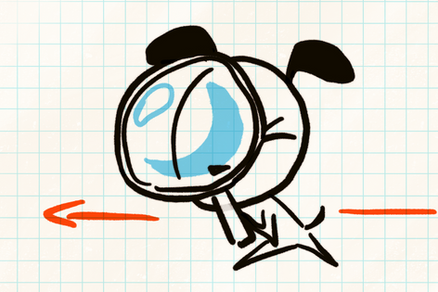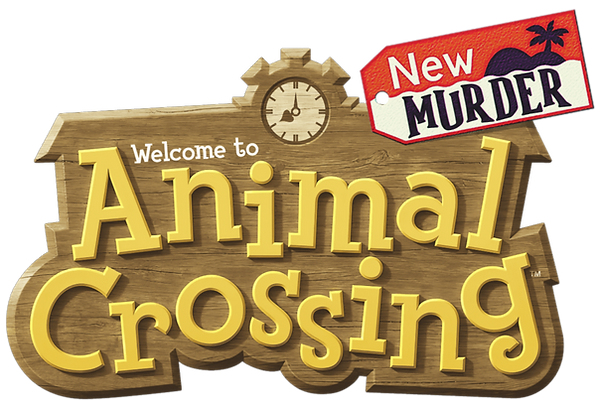
AC: New Murder is a humorous, character-driven, murder-mystery video game I created with my brother, Chris Padilla. Below I go into how the game works and my role in it.
AC: New Murder is an Ace-Attorney-like murder mystery game that pairs with Animal Crossing: New Horizons (ACNH) for exploration and storytelling.
LOOKING FOR A DETECTIVE
"A murder attempt happened last night with the local pupper, Lucky, as the victim! I was the one who discovered the crime scene so the villagers are blaming me! I need someone to clear my name and find the true culprit!"


Lucky was almost murdered and Ñenn is asking the player to figure out who really did it. The player needs to interview suspects and search the island for clues to get to the bottom of this mystery.
The game has two parts—1. a website that acts like a visual novel and 2. a dream island in the game ACNH. The exploration and evidence are on the dream island, and the story and progression are on the website. Each part feeds into the other, so there is some back and forth.
The game is free to play but requires a Nintendo Switch, a Nintendo Online Membership, and a copy of Animal Crossing: New Horizons to play. The game takes at least 7 hours to complete.
If you would like to play it, the game can be played on
More detailed instructions on how to play are there as well.
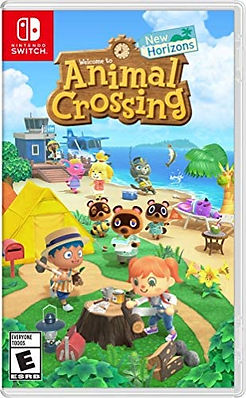
What I did:
-
Directed and Managed the project
-
Created the concept
-
Created the story
-
Wrote all dialogue and descriptions
-
Redesigned characters
-
Created all visual assets
-
Designed narrative progression
-
Designed the level/island
-
Worked closely with the programmer
-
Play Testing Coordination
-
UX Research
-
Marketed and advertised the game
My brother, Chris Padilla, and I created this project. I made the concept and a simpler plan. A couple of months later, my programmer brother came into the picture, and the project expanded exponentially. The game kept growing and growing, with interesting paths, gameplay ideas, and design components. Ideas and a certain level of advanced polish had to be rolled back to ensure we crossed the finish line. Completion was valued over perfection. The game took two years to create, from the initial concept to public release.
If you would like to learn more about the technical side of developing the game, you can read more about it on Chris’ website.
“The art style and story were both insane and I just couldn’t put it down."
“I recently got my degree in video game design and can confirm that the story and level design were wonderfully planned out and the game itself was a lovely and fun experience!”
“The mystery, while simple and memorable to an Ace Attorney’s first case, is so immersive that it feels almost impossible to have to put the game down, especially when it feels you’re getting closer to the end!”
“The mystery, while simple and memorable to an Ace Attorney’s first case, is so immersive that it feels almost impossible to have to put the game down, especially when it feels you’re getting closer to the end!”
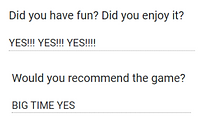
There are “AC: New Murder” spoilers on this page. The gameplay will be analyzed and the storyline will be discussed. If you haven’t played the game and would like to, I highly suggest doing so before continuing.
How it works
Essentially, there are two acts, with two chapters within each. Act 1 contains "Investigation" and "Trial 1," and Act 2 has "Recess" and "Trial 2." The two acts are similar in that they both start with a chapter filled with exploration and conversations and end with a trial. Act 1 is really a smaller and shorter version of Act 2. Players come into the game with their thoughts and biases about the characters, and Act 1 brings players on the same page to start Act 2 on the right foot. The act’s true purpose is to prepare the player and narrow the suspects for Act 2.
After Ñenn introduces the game, the player is encouraged to explore the island.
The player is given two tasks they have to complete to go to the trial, Talk to Villagers and Get Evidence.


"Talk to Villagers", AKA gathers testimonies, starts on the dream island in ACNH. The player runs around until they find a villager.
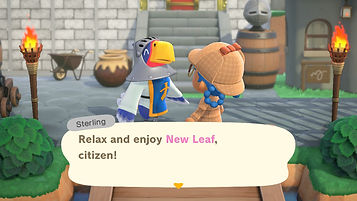
-
They talk to the dream island villager until they say their catchphrase.
-
With the villager’s catchphrase on hand, they hop onto the website, click the correct catchphrase, and read the villager’s testimony.
-
Once they are done with the conversation, the catchphrase is crossed off, and they’re ready to return to the dream island.

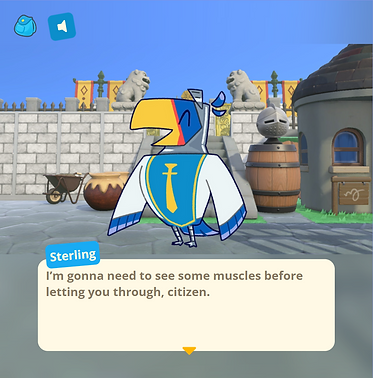

All villagers are locked within their house area, so the player can find them by looking at the map.


“Get Evidence” is similar to talking to animals; the player runs around the dream island until they come across a dropped item.
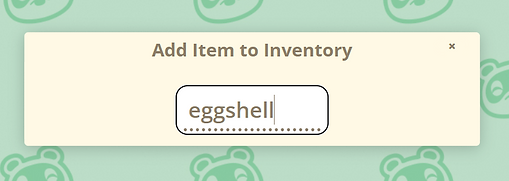
When the player types the item’s name in the “Add to inventory,” the website logs the item in the player’s web bag.
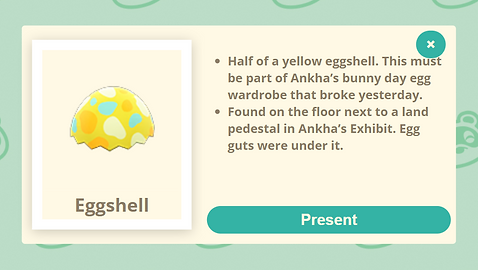

Logged items can be presented during the trials and recess.

Because of technical limitations, the bag can only be accessed during a conversation. To address that, “Bag Check” was added. It’s a short conversation that allows the player to open their bag. Hints are also available here.

The island feeds into the website, and the website spits the player back to the island. The frequent looping creates a lot of interactiveness and fun.
Once the player talks to everyone and gathers the needed evidence for the trial, they can start the trial.

The Island
The inclusion of the dream island is what sets AC: New Murder apart from any Ace-Attorney-like game. New Murder isn’t just a visual novel; it’s also a 3D platformer collectathon. Kind of. Hear me out.
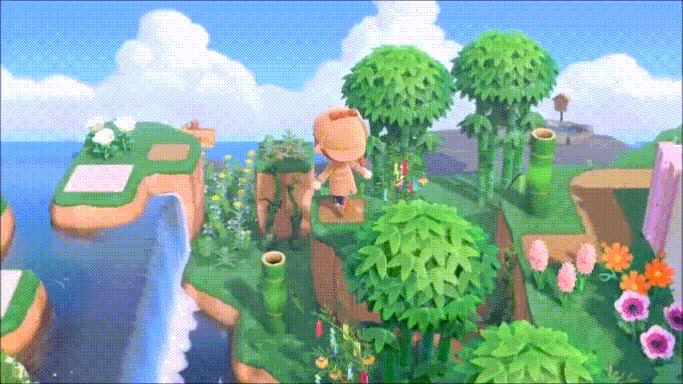
Through the dream island, the player explores a 3D space in search of multiple items. To get all items, the players have to perform (very) light platforming and solve light puzzles.
The dream island can be its own game. I used Animal Crossing: New Horizons as my very, very limited Unity.
“I really loved exploring the island for items/evidence. The terraforming and little obstacles to find some are rewarding and essential.”
The island’s primary goal is to serve as a fun way for players to find items. The secondary goal is to support the game’s story visually.



To give a contained example, Ankha’s
Exhibit has four pickable items. There is an
eggshell on the ground in the center of the
area, two items on these land pedestals,
and one out of reach next to the museum.
It is unclear to the player initially how to
reach the lader three. It isn’t until they
explore the whole area that they can find
the solution: to hop. An example of the
light game’s platforming and light puzzles.
As far as visually supporting the story, Ankha has a variety of items put on display. She seems to have a hoarding problem. The items may seem random, but there’s a theme if the player chooses to analyze them.
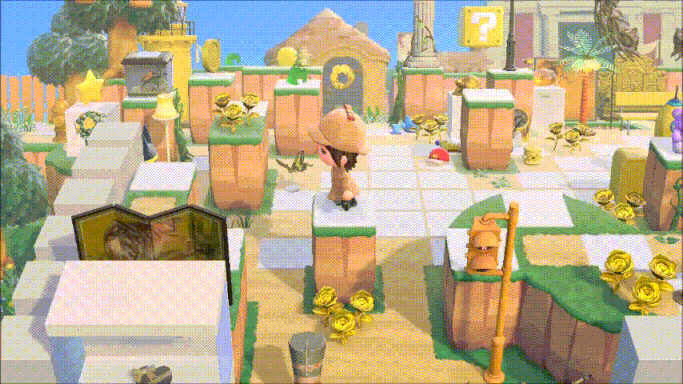
The player does not need to notice all of this to conclude that Ankha steals. Soon after first meeting her, there’s an implication she stole items from her neighbors. And later on, it’s revealed that this hobby of hers is connected to events that happen on the night of the murder attempt. The decorations on the island are meant to support the story and tie the island to the website.




Some of the items in her collection can be found in other places on the island—walls and fences, to a teddy bear and neon palm tree.


On top of that, in Ñenn’s ring are framed photos of all the villagers except Ankha. There is a framed photo of Ankha in her exhibit.



The Website
The website portion of the game is set up as a visual novel. The player clicks through pages of text and is sometimes prompted to answer questions or provide evidence. At times the story progresses linearly and gives the player few options to choose branch paths, like the trial. At other times the player is given the freedom of who to talk to and what to talk about, specifically in Recess.
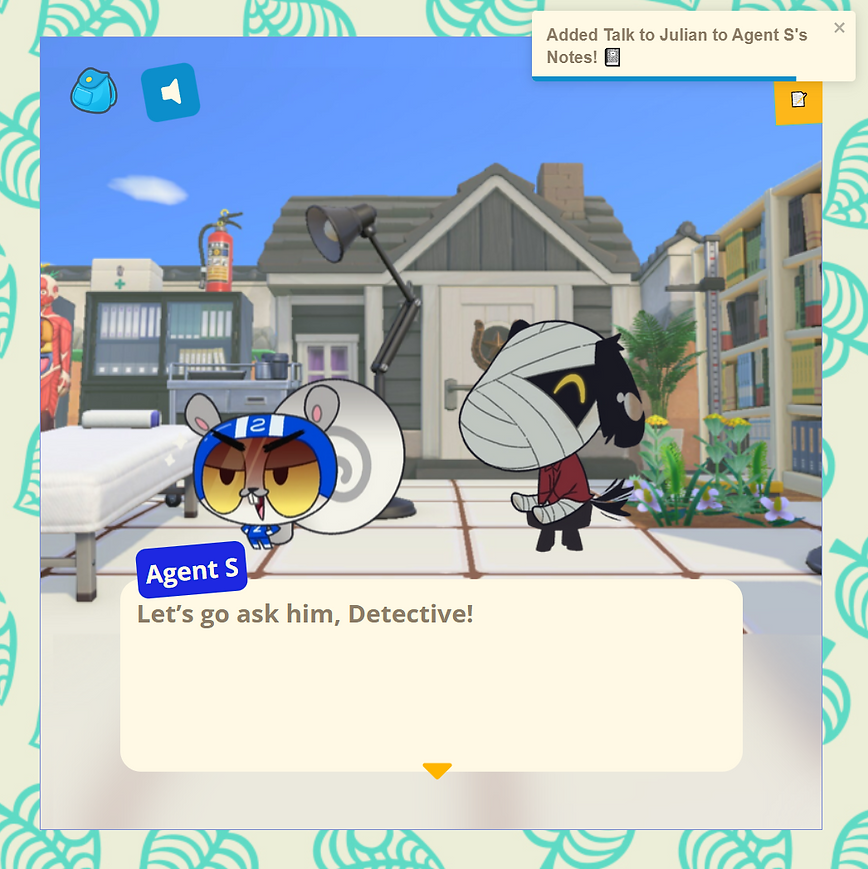
The villager talking comes forward while the character not talking is darkened. They can flip and slide in and out.
Each villager has 10 to 30 expressions. Some expressions are saved for more intense moments later in the story.
This tab contains notes that serve as a checklist. New notes are added here, and notes that are completed are checked off.
Pop-ups give updates on added and removed items, added and completed notes, the trial being unlocked, and achievements.
The button to turn the music on or off. All tracks were created by Chris Padilla.
The player can progress through dialogue by tapping, clicking, or pressing the -> key.
The bag button. Inside, the player has access to the animals, map, and items with descriptions of each. This is where items are entered.
Here is what zooming through the dialogue looks like. I picked the character, image, placement, and direction, and plugged it into the program we used, Sanity. Chris used Sanity to create the animations and transitions.
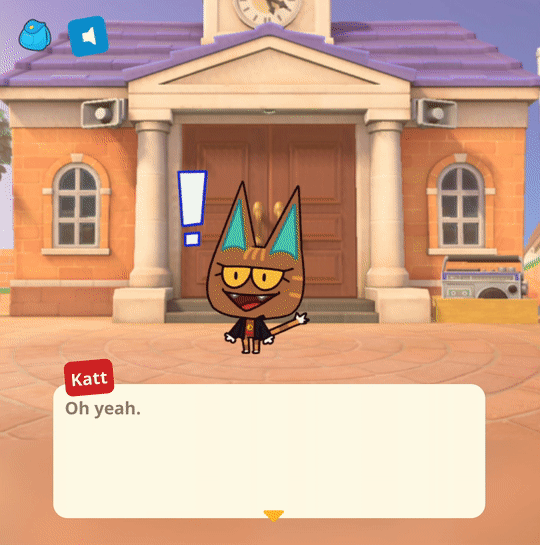
How it really works
The game is much more than it seems on the surface. The concept is fun and enticing, but the behind-the-scenes work and decisions make the game enjoyable. The game guides the player in the direction it needs to without feeling forced and prevents them from ruining the game for themselves. The mystery is laid out in a way that is satisfying and gradual. Information is revealed through the player’s actions. AC: New Murder is a fleshed-out game, not a story to read passively.
“… [AC: New Murder] was extremely well written with the twists that were implemented as the characters were more introduced. By the time that I was halfway through, I had trouble figuring out who was the actual culprit. It had felt that clues were consistently leading to multiple people and even if it had seemed that a specific villager was the culprit, there would still be more to the case that kept the story wheel going.”
Gates
The player has a lot of freedom in Recess, but gates are placed throughout the chapter to prevent players from seeing dialogue early. There are two types of programmed gates: Prerequisites and Updated Items. They work in a very similar way.
Prerequisites need a specific conversation to check it off before allowing a player to present a certain item to a certain villager. Agent S gives the player a “wait til later” line when the conversation hasn't been checked off yet.

The player can’t present the cake to Katt until Sterling tells them that he dropped a cake off at Katt’s Junkyard.

Updated items are items that get updated with a specific conversation. Presenting the pre-updated item to a specific character will not give the story-related response needed to progress, but presenting the updated version will.
Despite doing basically the same thing, updated items are helpful in specific situations where villagers have something to say before and after certain information is revealed.
For example, presenting the pre-updated eggshell to Ankha leads to a dead end, and Agent S gives the player a hint. Presenting the eggshell to Lucky triggers a memory (needed to progress to the trial) that causes the player’s knowledge of the eggshell to change to be

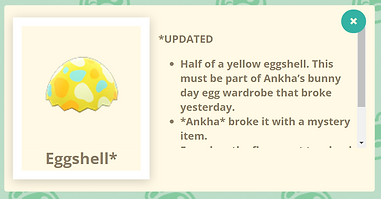
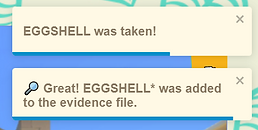

updated. Ankha gives a much more juicy response to the updated eggshell, and the conversation ends with an achievement. Ankha’s updated eggshell response isn’t necessary to progress, but Lucky’s response to the pre-updated
Chaining different gates together can create strings of narratives.
eggshell is what Ankha’s initial conversation points to.
Strings
Recess can come across as having little direction, but there are narrative strings under the surface that direct the player in the right direction. Every dialogue that is not a one-off flows toward important information.
Presenting the cake to Lucky sparks a memory, which is essential to move on to the trial. After the memory, Lucky tells the player that he found a kitchen appliance. The problem is that he buried it in an out-of-reach area. Trees block the way; an axe is needed to get through. It is mentioned that Julian probably has an axe, so the player is given access to Julian.
Bringing the appliances to Merengue rewards them with the info of what she was really up to the night prior.







Merengue gives the player a quest; she asks the player if they could find three kitchen appliances. At this point, the player most likely only has two kitchen appliances. They have to come back later.
After asking the player that, Merengue tells them the five characters, she gave a cake to last night, Lucky being one of them. If the player goes to the other four characters who received a cake, Agent S will remind them who also got one after the conversation.
Julian has an axe, but he won't say where until the player solves his riddle. Specifically, the riddle reveals where the axe is buried. The player must go back onto the island to locate the tool. Once they retrieve the axe, they can go to Lucky’s burial spot to uncover the last kitchen appliance.
Through this string, the player gains access to Julian, can present any item to Merengue and Julian, and sees one of Lucky’s memories. This journey involved seven different notes, and two of them are required to move on to the trial. This string also a great example of how the game's mechanics feed into each other.
The strings also help to tie the villagers together as a single community on a small island. They talk about each other, and the player is forced to jump between the characters to reach a single goal.
“You can really start to get a picture to the society of villagers and the relationships they have with one another.”
Writing
I am very proud of the writing. The game follows a humorous, light-hearted tone with sprinkles of tasteful fourth wall breaking. The writing is very character and interactivity focused, to the point of being compared to earlier Animal Crossing titles that put more attention on interactions with villagers. Comparable to Paper Mario or Phoenix Wright's style of characterization. The story, dialogue, and even bag descriptions are filled with humor, delight, imagination, depth, and mystery.
A few serious topics do pop up, but they are treated with respect and optimism. I’ve seen players dread the sadness or seriousness they predict, but they’re always pleased to find that the positive tone does not shift.
“It has its witty charm and all the characters were lovable in their own way!”
The overarching story is engaging and is always progressing forward. It goes along with the player’s actions, and the mystery unwinds itself gradually. The "How it Really Works" section goes more into that.
“The villagers’ dialogue and art reminded me about the past games of the Animal Crossing franchise and the way it brought back more personality despite it being played in New Horizons! Each character was clearly written with a certain personality and never lost that sort of sense as the story progressed, something that I wished was still kept in the more recent games.”
A lot of effort went into trying to keep the characters consistent and true to their New Horizons counterparts. I studied a website that had all of ACNH’s dialogue. I went through each personality type and wrote down phrases and characteristics. When I reviewed the dialogue I wrote, I ran it by my guides to make sure I was keeping them in character. It helped sell the idea that these characters really are the same characters in New Horizons.

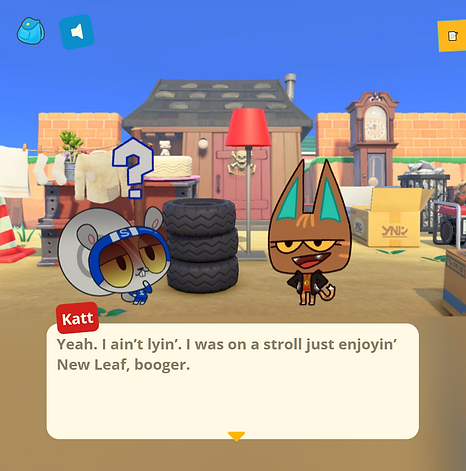
If you would like a taste of writing for an array of unique characters, the first part of the game, Investigation, does not require Animal Crossing: New Horizons to go through. You can go to acnewmurder.com/play and press play, or you can go through this link to skip Ñenn’s intro. Ñenn’s intro explains the game and goal to the player. Once you’re at the hub, click whatever catchphrase you would like. “:),” “UwU,” “sunshine,” “mortal,” and “sidekick” are my personal favorites.
If you don't mind spoilers, I included a couple of scripts to the right. "1st Trial" has me juggling 10+ characters, and "Recess Ankha" has some of the more juicy dialogue in Recess.

Below is one of my favorite jokes from the Investigation. I don’t suggest watching if you plan to check out Investigation or the game. The streamer is nightospout.

Art
I used my background as a visual artist to bring the game to life. Each character is reimagined for the web portion and is given 10-30 expressions.












I went through tons of quick sketches to feel out the design I was looking for. Some characters took more tries than others.
For Elvis, I was going for a grumpy retired king who actually is just shy and loves to talk about his daughter.


I used the emotes in Animal Crossing: New Horizons as inspiration. Each character has its own set of emotes. All characters have a "Thought" drawing, but not everyone cries.
“Using screenshots from the environments in ACNH as backgrounds for the Web Portion was a genius move that made the whole thing feel very Animal Crossing throughout, and the art style for the characters is SOOO lovely, endearing, and dynamic, All of the characters’ personalities really shone through the artwork.”
Lucky’s memories are translated into crude storyboards. They are meant to look like Lucky drew them himself. This choice was actually a decision to save time once I realized storyboarding five sequences for an already ambitious project was too ambitious. The change has brought charm and expanded on Lucky’s innocent personality.
Challenges
As all great projects do, AC: New Murder faced challenges. I want to go over a couple of issues that popped up during development that I addressed. The problems I overlooked were mostly disconnects between players and the game design. Bugs went to Chris. If you would like to learn about them, you can check his website.
Missing the cake

In the 2.0 update, Animal Crossing: New Horizons made it so all dropped food items will appear as a cover food dish, not the iconic leaf icon. This made it harder for testers to notice Cake. I moved it to the floor and testers still struggled. I eventually made a character tell the player not to pick up food items during the Investigation stage. That completely fixed the problem.
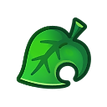


Out of Reach Items

There are three “out of reach” spots (red outline) on the island where the player needs a hidden tool to reach. This game feature gives the players something to look forward to and excitement once they can access the areas. Without them, the player would have no reason to return to the island after the Investigation. It has caused trouble, though. These spots are not meant to test the player’s puzzling or scavenging skills; they are intended to serve as roadblocks.
The thing is, it’s impossible to enforce these roadblocks. Everything the player needs is somewhere on the island. A lack of knowledge is what creates the block, but whether it’s through luck or cleverness, the player could get past it.
Conversely, some players would get obsessed with trying to make it to the restricted area and think they are missing something. They believed ‘if I just run up and down the island for an hour, I’ll figure it out.’
Both of those situations were unfavorable and could dampen the player’s experience. Over the months of testing, many changes have been made to discourage those behaviors.
Things were done on the island to push players away from finding hidden items like:
-
Remove unnecessary items that could be consumed and used to dig up trees.
-
Insert a decoy and extra barriers.
-
Move furniture in a way that hides paths.
-
Add another tree to the tree barrier.
-
Add more cover to hide an item.
-
Discourage the player from spending too much time on the island through web-game dialogue.


I made more changes to the web game to curb the players’ desire to tear the island down to find hidden items:
-
I changed Ñenn’s dialogue in the beginning and Recess to be more forward with the idea, “You can’t get all items on your own.”
-
I also added lines addressing it in both situations where the player can ask for hints. The hints in Recess have the option to ask directly, “I can’t get to some parts of the island.” Most answers address that the player can get there if they continue the web game.
Despite all the progress, neither of the situations can be entirely prevented. The root of the problem for both issues is how the player views these challenges, and I have limited power over that. The ideal solution would be to create an island and ditch the Animal Crossing one. I could make it impossible to get items early and create more visual cues to express some areas aren’t reachable yet. Of course, that would completely change the project and require more time and learning.
The actual solution I implemented was accepting what I could not control and adjusting what I could. It doesn’t actually matter if the player finds items early because of the gates placed. The items can’t be presented in-game until it is time to present them. And if the player keeps playing, they will eventually be told where to find the hidden items.

To present a specific item from a restricted area, the player must have at least 13 unique conversations between 5 different characters. This isn’t one string of conversations but four strings that end up merging.
Even though I’m framing these as problems, they have their positives. People who find items early feel smart, and the people who obsess are more invested.
Thinking back to the first streamers I watched during beta testing, two of them were feral over trying to get to one spot on the island. This was before I did anything to address that. But once they were told where they could find the tool they needed, they had such strong emotional responses. One was celebrating with her chat going wild. The other was so mad. Not at the game but at the character who withheld the information. I definitely don’t want to make anyone mad, but it did bring emotions into their playthrough. Both of those streamers gave raving reviews and feedback.
This streamer, shutupsprinkles, is one of the first beta testers and, at this point, had been searching high and low for a vaulting pole she could use to reach a restricted area.

Marketing
The marketing strategy has been sharing the game on social media and asking streamers if they would like to play the game on stream. I don’t think the game has reached “viral” status yet, but it has only been a month at the time I’m writing this, so who knows. ;) It has gotten to the point that it’s being shared in places I’m entirely unaware of. It’s always nice to see random spikes of traffic.
Since Ñenn represents me, I play as her online. So basically I go around asking for a detective to clear my name. I have no clue if it helps with the marketing, but it can be a lot of fun in twitch chats.

It's always in good fun, of course.


"Think Ace Attorney, but it’s ACNH"

"Explore the dream island “New Leaf.” See what clues you can find. It may seem peaceful, but a crime took place here!"

"Play now!"

"Think Ace Attorney, but it’s ACNH"
I included this marketing section because I wanted to show off the collages I made above.
The trailer at the top of the page was made by Lorenzo Estrada.
Overall, people have enjoyed playing the game and we have enjoyed making it. Thank you for reading. If you are looking for a game designer or game writer, I can bring the skills you’re looking for. You can reach me at jennpadillart@gmail.com















